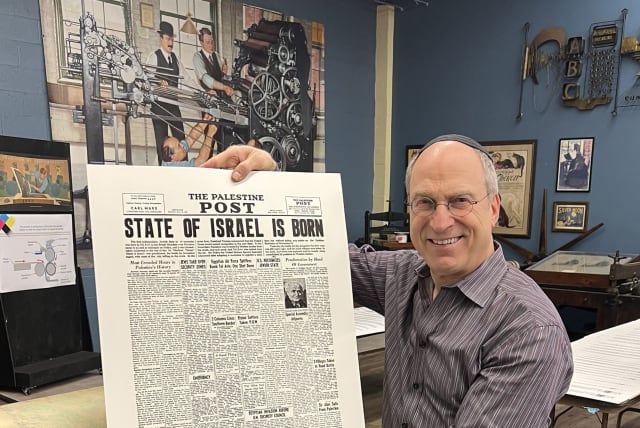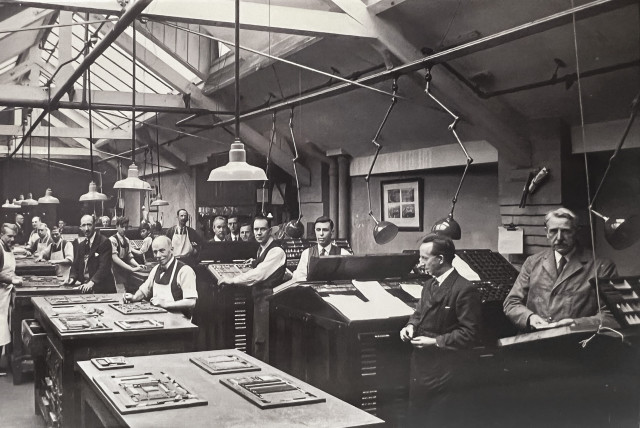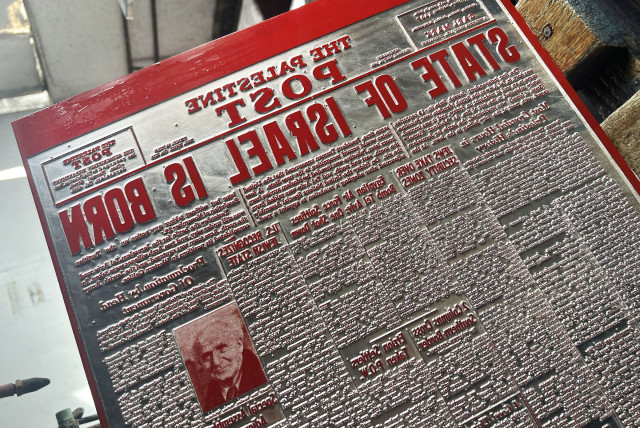Israel Independence Day: Recreating the 'Post's iconic 1948 front page

Finding an original 1948 copy of The Palestine Post on Israel's independence and recreating it to preserve it.
It was the summer of 1967 and I had just taken my first propeller plane flight from New York to Toronto to visit my grandparents. Just a few months earlier, Israel miraculously won the Six Day War but being only nine years old, I was too young to appreciate what that meant. Instead, my eyes were fixated on my grandfather’s Heidelberg windmill printing press. With the flick of a switch, his hands, blackened by ink, sent the press whirring to life.
Whoosh, snap, thump, whoosh, snap, thump are the mesmerizing whirlwind of movements and sounds of rubber suction cups lifting sheets of card stock and snapping them in place for steel plates to crash mightily upon them. It was a perfectly choreographed dance of human and machine.
Moments later, my grandfather handed me my first letterpress printed card. It was a wedding invitation. I ran my fingers over the paper, feeling its texture. The touch, sight and smell of fresh ink combined, turning it into an immersive sensory experience.
And so began a lifelong love of the printed word and the typography that composed it.
Ten years later, I enrolled at the School of Visual Arts in New York, where I studied graphic design. My favorite class was typography, where I learned about the gracefulness of letterforms, fonts, kerning (spacing between letters) and page layout. Those were the days before the digital revolution when everything was done by hand and every project ended up on a printing press.
As a child of Holocaust survivors who experienced the horrors of Auschwitz and Mauthausen, my appreciation of Jewish history, the long exile and the miracle of modern Israel were always present. As a young adult, my trips to Israel began to include museum visits and archaeology digs and soon enough, I was purchasing Judean oil lamps, Bar Kochba coins and 18th-century maps of ancient Israel. Holding a coin or oil lamp in my hand that another Jewish handheld 2,000 years ago was thrilling. It not only transported me back to a time of Jewish sovereignty but much like the letterpress invitation my grandfather gave me, it connected me to the artisans who left their impressions on these precious artifacts.
Finding a 1948 Palestine Post paper on Israeli independence
IT SHOULDN’T be surprising to hear that when, in 2022, I saw an original 1948 newspaper of The Palestine Post, declaring in a simple, yet strikingly bold headline “State of Israel is born” in a Jerusalem antique shop, I knew I had to buy it.
The typography was, of course, familiar to me. I recognized the fonts and appreciated the beautiful letterpress qualities. But reading the content also transported me back in time. I sensed the fragility of the new state and the existential threats as Israel was attacked from all sides. I could feel the excitement of the day but also the anxiety.
My heart shuddered as I imagined myself back in 1948, wondering whether the hundreds of Haganah men and women fighters in the Kfar Etzion block would survive. And whether Tel Aviv might be destroyed by Egyptian Spitfire aircraft or by the two columns of troops and artillery that just crossed the southern border. But it also raced with excitement about the battle for Jerusalem and the Old City and the importance of the day: the United States’ recognition of Israel and of course, Ben Gurion’s declaration of the state.
Then my eye caught a small post on the bottom that described the challenges the publishers faced in printing the legendary paper. The state of emergency in Israel, the country-wide blackouts and the power failures in Jerusalem quieted the very same Linotype typesetting machines I remembered clanking lead letters as a child. The paper almost never got published and now, I had one in all its original glory.
Excited to frame and hang it up, I learned of some troublesome news. Displaying it on a wall would expose it to UV light which could make it not only fade and turn yellow but also turn brittle. Historic documents need to be protected in acid-free archival materials and stored in cool, dry conditions.
As a graphic artist, I knew I could digitally scan the original but that just wouldn’t do it justice.
I had a grander – some would say crazy – idea. What if I reprint the newspaper using the exact same techniques as was done 75 years ago? Would that even be possible?
Reprinting a 75-year-old newspaper
And so, I endeavored to use my 40-plus years of design and printing experience, along with some tenacity and persistence to masterly pull off a remarkable reproduction using 75-year-old methods and technology.
I located a company that still made letterpress plates. When I entered the building, I was transported back in time to 1977, when I first started working at a printing company. Paper job tickets, a huge bellowed camera, a dark room, light tables for stripping and opaquing film negatives, vacuum frames and acid baths for making plates. It was surreal.
Placing the original newspaper in the camera and seeing the image develop on a huge sheet of black film was exhilarating!
As I watched the many stages of plate making – magnesium being exposed to UV light, then bleached and acid-sprayed in a huge steel tank, washed, gouged and mounted to a block of cherry wood – I thought “All this for one page!” I couldn’t imagine the sheer volume of laborers and equipment it took to produce a newspaper of 50 or 100 pages.
WITH THE plate in hand and beautiful 100% cotton paper from Cranes (the company that manufactures the paper used in United States currency) procured, I located one of the few remaining places in America that have vintage presses large enough to print this heritage piece. My heart skipped a beat when I learned that it was an educational museum and not a trade or commercial printer to the public.
Not to be deterred, I took a chance and called the director of the museum. I described the project to him and the historic nature and conditions of the original publication. To my utter delight, he said “Let’s do it!” It would have to be done on a vintage 1962 proof press – essentially a hand-operated machine – but the end result would be the same.
The process would be very slow – feeding one sheet at a time and rolling it over the plate with a significant amount of muscle – but at this point, I was running on adrenaline. I rushed to the museum – a nostalgic and sentimental experience itself – where we mounted the plate, inked the press and ran several test sheets to get the positioning and ink pressure just right.
Here I was, printing something historic, in the exact same way it was done in 1948. The final sheet came out breathtakingly beautiful with all the nuances of the typography of the original newspaper, including uneven columns, broken type and tiny impressions between individual letters authentically reproduced. I thought it was remarkably accurate and in many ways more beautiful and impactful than the original.
There is really nothing that matches the tactile feeling of ink on paper. The relationship is so much more visceral than looking at a computer screen or smartphone. Running my hands over the sheet and feeling the impressions of the letterforms just as I had done as a child in 1967 was just so exciting. And knowing how much work went into that single sheet of paper made it all the more meaningful.
I always had a love and appreciation for design, printing, history, archaeology and the modern miracle of the establishment of Israel. All those interests converged into one with this project and it allowed me to step back in time and connect to what that exciting day must have felt like, 75 years ago.
A parting and personal thought: This paper and the famous Bar Kochba coins represent the bookends of the exile. Those coins are one of the last known expressions of Jewish sovereignty in antiquity and were minted in 135 CE. This newspaper, printed 1,813 years later, was one of the first expressions of the Jewish sovereignty of the newly established state. It will always have a special place in my heart. Am Yisrael chai! ■
A limited number of sheets were hand-printed and certified and are available to those who would like to frame and display this most momentous day in Jewish history. For more information, visit: www.state-of-israel-is-born.com
Jerusalem Post Store
`; document.getElementById("linkPremium").innerHTML = cont; var divWithLink = document.getElementById("premium-link"); if (divWithLink !== null && divWithLink !== 'undefined') { divWithLink.style.border = "solid 1px #cb0f3e"; divWithLink.style.textAlign = "center"; divWithLink.style.marginBottom = "15px"; divWithLink.style.marginTop = "15px"; divWithLink.style.width = "100%"; divWithLink.style.backgroundColor = "#122952"; divWithLink.style.color = "#ffffff"; divWithLink.style.lineHeight = "1.5"; } } (function (v, i) { });



